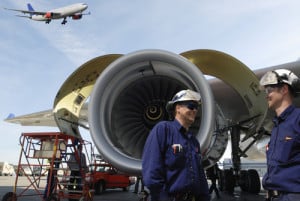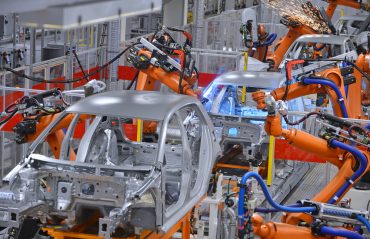
What if companies knew when machines might break down?
Predictive maintenance, which combines IoT sensors and algorithms that enable real-time analytics, can serve many sectors, providing visibility into high-value, industrial assets that are expensive to maintain—including power plants, manufacturing, process, mining, transportation, aerospace and defense. In the industrial sector, a single piece of equipment can cost millions — a gas turbine, for instance, costs up to $1 billion. An oil rig runs more than $600 million.
Some companies that currently use predictive maintenance solutions include: Thyssen Krupp for elevators; Rockwell Automation for oil and gas equipment; and General Electric for a variety of uses in the industrial sector, such as power plant equipment, aircraft, and oil and gas operations.
An Industrial Test for Predictive Maintenance
Under the aegis of the Industrial Internet Consortium (IIC), two vendors—IBM and National Instruments (NI)—are collaborating on an initiative called the Condition Monitoring and Predictive Maintenance Testbed that intends to provide a cloud-based predictive maintenance solution which will offer continuous online measurements, automated analysis, and balance of plant coverage.
The goals of the testbed are to help increase equipment uptime and prevent catastrophic failures, as well as provide condition monitoring data to experts through the cloud, according to the IIC. The program’s organizers intend to develop new predictive maintenance analytics modeling techniques, document standards, secure architecture patterns, and data formats for predictive maintenance.
Condition monitoring is defined as “the use of sensors in equipment to gather data and enable users to centrally monitor the data in real-time,” according to the IIC. Predictive maintenance applies analytical models and rules against data to proactively predict an impending issue, then “deliver recommendations to operations, maintenance and IT departments to address the issue,” the IIC says.
Getting Industrial Systems Ready
Many industrial systems or machines are simply not ready for the Internet of Things (IoT), according Jamie Smith, Director of Embedded Systems Product Management and Product Marketing for NI (and a coordinator for the effort). In an IIC blog post that he co-wrote entitled, “Introducing the Condition Monitoring & Predictive Maintenance Testbed,” Smith explained that the current state of condition monitoring requires manual measurements that are compounded with aging equipment and the retirement of knowledgeable personnel.
“Organizations in the industrial sector—energy, water utilities, oil and gas, manufacturing, mining and transportation—have a lot of pre-existing equipment that isn’t instrumented,” he wrote. “Truth be told, the equipment is just old. Most of the industrial machinery in use is at least 10 years old. Not since 1938 have North American factories worked with such out-of-date equipment.”
Such aging infrastructure can benefit from monitoring and predictive technology, according to Smith. To bring industrial equipment up-to-date by today’s standards, “modifications need to be made so that these machines are able to fully harness the potential of the IoT,” Smith says. “For example, installing sensors and software for condition monitoring helps provide greater insight into the machine’s performance and health, and can help to detect early indicators of performance issues or failure in advance of catastrophic and costly repairs. Even greater potential lies in adopting analytics technologies for predictive maintenance to recommend maintenance actions to correct an issue before there is unforeseen downtime or a dangerous situation occurs.”
Validating Use Cases
Through this testbed, IBM and NI, the testbed’s sponsors, will explore the application of a variety of analytics technologies for condition monitoring and predictive maintenance. “The IBM-NI testbed combines IBM’s cloud environment and analytics with NI’s monitoring and data acquisition tech to provide this IoT industry use case validation,” said Sky Matthews, distinguished engineer and CTO for the Internet of Things at IBM, in the blog post he co-wrote with Smith. “Organizations can use the testbed for condition monitoring, predictive maintenance, performance, and cost of technologies they’re considering. For example, a mining company would be able to monitor and ensure its machines run reliably, even when operating at a higher level in order to resolve an issue before it becomes a dangerous situation.”
These capabilities enable new ways to monitor the operation of the equipment (such as turbines and generators) and processes, and to adopt proactive maintenance and repair procedures rather than fixed schedule-based procedures. This can, potentially, save money on maintenance and repair, and save costs and lost productivity due to downtime caused by equipment failures, according to the IIC.
“Combining sensor data from multiple pieces of equipment and/or multiple processes can provide deeper insight into the overall impact of faulty or sub-optimal equipment,” the IIC elaborates, “enabling organizations to identify and resolve problems before they impact operations, and improve the quality and efficiency of industrial processes.”
According to the IIC, the testbed application will initially be deployed to a power plant facility where performance and progress will be reported on, additional energy equipment will be added, and new models will be developed.
So many articles, so little time. Luckily, our content is edited for easy web reading! Read more:
Research from Gartner: Real-Time Analytics with the Internet of Things
From the Center to the Edge: The IoT Decentralizes Computing
Becoming an ‘Always On’ Smart Business
Urgency of Present and Past in IoT Analytics




























